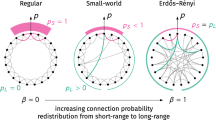Abstract
This paper introduces a new model and methodological approach for dealing with the probabilistic nature of mobile networks based on the theory of random graphs. Probabilistic dependence between the random links prevents the direct application of the theory of random graphs to communication networks. The new model, termed Random Network Model, generalizes conventional random graph models to allow for the inclusion of link dependencies in a mobile network. The new Random Network Model is obtained through the superposition of Kolmogorov complexity and random graph theory, making in this way random graph theory applicable to mobile networks. To the best of the authors' knowledge, it is the first application of random graphs to the field of mobile networks and a first general modeling framework for dealing with ad‐hoc network mobility. The application of this methodology makes it possible to derive results with proven properties. The theory is demonstrated by addressing the issue of the establishment of a connected virtual backbone among mobile clusterheads in a peer‐to‐peer mobile wireless network. Using the Random Network Model, we show that it is possible to construct a randomized distributed algorithm which provides connectivity with high probability, requiring exponentially fewer connections (peer‐to‐peer logical links) per clusterhead than the number of connections needed for an algorithm with a worst case deterministic guarantee.
Similar content being viewed by others
References
D.J. Baker, A. Ephremides and J.A. Flynn, The design and simulation of a mobile radio network with distributed control, IEEE Journal on Selected Areas in Communications (1984) 226-237.
D.J. Baker, J. Wieselthier and A. Ephremides, A distributed algorithm for scheduling the activation of links in a self-organizing, mobile radio network, in: Proc. IEEE International Conference on Communications(ICC '82), Philadelphia (1982) pp. 2F.6/1-5.
B. Bollob´as, Random Graphs(Academic Press, London, 1985).
H. Buhrman, J.-H. Hoepman and P. Vit´anyi, Optimal routing tables, in: Proc. 15th Annual ACM Symp. on Principles of Distributed Computing, Philadelphia (1996) pp. 134-142.
A. Ephremides, J.E. Wieselthier and D.J. Baker, A design concept for reliable mobile radio networks with frequency hopping signaling, Proceedings of the IEEE 75(1) (1987) 56-73.
P. Erd´´os and A. R´enyi, On the evolution of random graphs, Proceedings of Hungarian Academy of Sciences 5 (1960) 17-61.
M. Gerla and J.T.Z. Tsai, Multicluster, mobile, multimedia radio network, Wireless Networks 1(3) (1995) 255-265.
A.N. Kolmogorov, Three approaches to the quantitative definition of information, Problems of Information Transmission 1 (1965) 1-7.
M. Li and P.M.B. Vit´anyi, An Introduction to Kolmogorov Complexity and its Applications(Springer, New York, 1993). 156 I. Chlamtac, A. Farag´o / A new approach to peer-to-peer mobile networks
C.R. Lin and M. Gerla, A distributed architecture for multimedia in dynamic wireless networks, in: Proc. IEEE GLOBECOM, New York (1995) pp. 1468-1472.
C. Lin and M. Gerla, A distributed control scheme in multi-hop packet radio networks for voice/data traffic support in: Proc. IEEE International Conference on Communications(ICC '95), Seattle (1995) pp. 1238-1242.
E. Palmer, Graphical Evolution(Wiley, New York, 1985). Imrich Chlamtac received his Ph.D. in computer science from the University of Minnesota (1979), B.Sc. and M.Sc. degrees in mathematics awarded with the Highest Distinction. He currently holds the Distinguished Chair in Telecommunications at the University of Texas at Dallas, and is the President of Boston Communications Networks. He is the author of over two hundred papers in refereed journals and conferences, mutliple books and book chapters. Dr. Chlamtac is the founding Editor-in-Chief of the ACM-URSI-Baltzer Wireless Networks (WINET) and the ACM-Baltzer Mobile Networks and Applications (MONET) journals. He served on the editorial board of IEEE Transactions on Communications and other leading journals. He served as the General Chair and Program Chair of several ACM and IEEE conferences and workshops, was a Fulbright Scholar, an IEEE, Northern Telecom, and BNR Distinguished Lecturer. He is the founder of ACM/IEEE MobiCom and of ACM Sigmobile of which he is the current Chairman. Dr. Chlamtac is an IEEE Fellow, an ACM Fellow and an Honorary Member of the Senate of the Technical University of Budapest. E-mail: chlamtac@utdaallas.edu Andras Farag´o received his M.Sc. and Ph.D. in electrical engineering from the Technical University of Budapest, Budapest, Hungary, in 1976 and 1981, respectively, and in 1996 he obtained the distinguished title "Doctor of the Hungarian Academy of Sciences". He joined the University of Texas at Dallas in 1998 as Professor of Computer Science. Until 1997 he was with the Department of Telecommunications and Telematics, Technical University of Budapest, and obtained the distinguished Szechenyi Professorship from the Hungarian Ministry for Education. At the Technical University of Budapest he was co-founder of the High Speed Networks Laboratory, a telecom research laboratory supported by Ericsson. He worked as a visiting Senior Research Fellow at the University of Massachusetts at Amherst in 1991-1992. He spent a sabbatical year at Boston University in 1996. He is member of IFIP Working Group 6.3 "Performance on Communication Systems" and founder member of the Hungarian Chapter of ACM. His main research interest is in developing algorithms and applying mathematical methods for the design and optimization of wired and wireless networks. E-mail: farago@utdallas.edu.
Author information
Authors and Affiliations
Rights and permissions
About this article
Cite this article
Chlamtac, I., Faragó, A. A new approach to the design and analysis of peer‐to‐peer mobile networks. Wireless Networks 5, 149–156 (1999). https://doi.org/10.1023/A:1019186624837
Issue Date:
DOI: https://doi.org/10.1023/A:1019186624837




